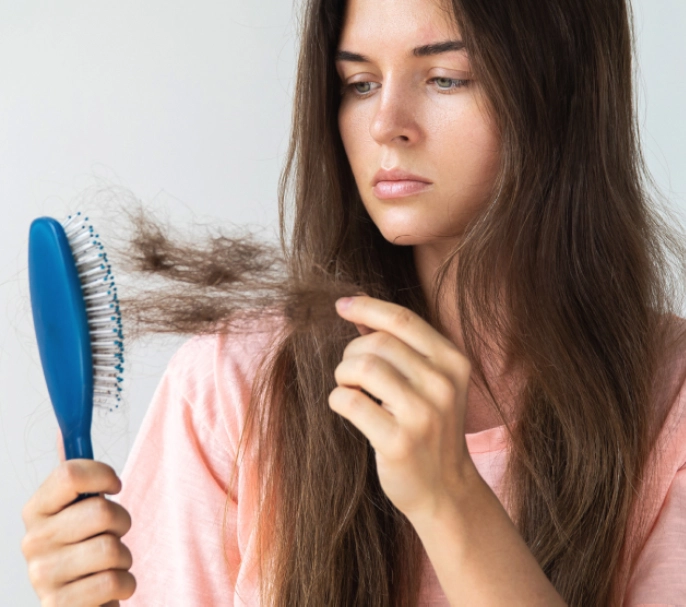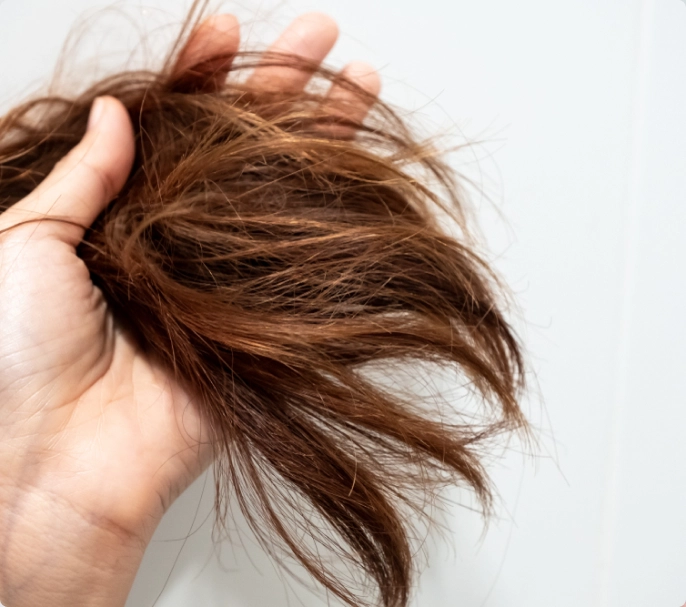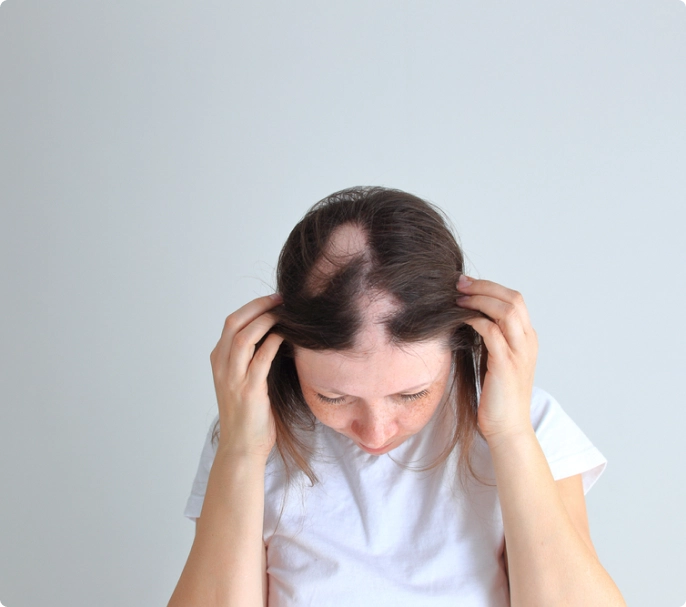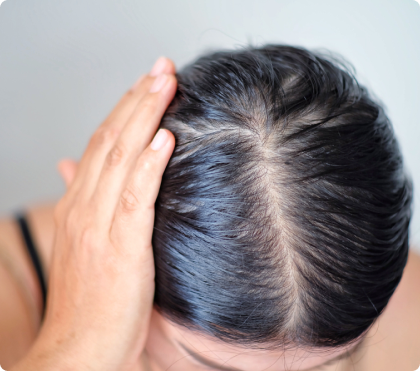
Female Hair Loss
On these pages we would like to inform you about the best known and most common forms of hair loss in women.
Get In Touch
Types Of Female Hair Loss
Not all hair loss is the same. In some cases it is hereditary, while in other cases e.g. stress, an unbalanced diet or diseases are the trigger.
All they have in common is the result: thinning hair. The most commonly occurring forms are “diffuse hair loss” and hereditary hair loss. Another form is circular hair loss (alopecia areata), which produces clearly delimited bald patches.
The causes of circular hair loss are not yet fully understood, but it is assumed to be an autoimmune disease. In each case, the treatment should be administered by an experienced dermatologist.
Contrary to popular belief, hair loss is not a purely male problem, around 40% of all women suffer from a form of hair loss at least once in the course of their life requiring treatment.
Get In Touch

Diffuse Hair Loss
If the entire head is affected by hair loss and the number of hairs lost exceeds the normal amount of 100 hairs per day, this is diffuse hair loss.
Although the hair bulb is intact, it is not sufficiently supplied with nutrients like amino acids (e.g. cystine) and B-group vitamins through the bloodstream.
This has consequences:
The hair bulb ceases its activity at some point – The life of the hair is shortened – It falls out prematurely – Increased hair loss is the result.
Get In Touch

Reasons For Diffuse Hair Loss
women, it is mainly caused by certain life circumstances:
- Stress
- Nutritional deficits/diet
- After pregnancy
- Severe infections, e.g. flu
- Certain metabolic disorders
- Special form of seasonal hair loss (hair loss in spring or autumn)
Get In Touch


Treatment
The cause of diffuse hair loss should be identified and, if possible, eliminated during a visit to the doctor.
Hair loss can also be successfully treated by supplying suitable nutrients, e.g. Pantogar®.
Because of the hair’s life cycle, the treatment should be carried out for at least 3 to 6 months.
3
Times a day
3-6
Months
Alopecia Areata
This form of hair loss is also called circular hair loss, or spot baldness. It is characterised by distinct, sharply defined bald patches of different sizes.
Alopecia areata is an inflammatory, usually reversible form of hair loss. The cause is unknown.
Most likely, immunological (concerning the body’s defence mechanism) processes play a role in the development of the disease. Hereditary factors also seem to be of relevance, as in about 25% of cases the disease occurs in families.
Alopecia areata should be treated by a doctor.
Get In Touch

Hereditary Hair Loss In Women
When women’s hair thins, especially in the crown area, this is usually a matter of genetic predisposition.
A tendency towards hair loss is passed down from parents to their children. In these cases, the hair bulb reacts very sensitively to the body’s own hormones that control hair growth. Hair becomes shorter and thinner.
Finally, only very fine and short hair grows.
Hereditary hair loss is the most common form of hair loss in men, accounting for 95 percent of all cases. But what many people do not know is that women can also suffer from this androgenic alopecia.
In addition to the basic cause of hereditary predisposition, the following factors can lead to this form of hair loss in women:
- Change of life (menopause)
- Hormonal imbalances
Get In Touch

Diffuse Hair Loss Has Many Triggers
Diffuse hair loss can have many different causes. It often occurs in situations in which the body or mind are debilitated, e.g. through stress, illness, unbalanced diet or hormonal fluctuations. Other possible triggers include e.g. medications or simply aging.
Regardless of the actual trigger, diffuse hair loss occurs in the same pattern: the activity of the hair root is disrupted, causing it to cease gradually. This leads to a disruption in the hair growth cycle. The result: hair loss.
Get In Touch
Stress and mental strains
Many people today feel that their lives are hectic and stressful – and this also affects their hair. Unfortunately, stress cannot always simply be switched off, e.g. at work. This makes it all the more important to address the consequences and halt stress-induced hair loss with Pantogar®.
Diet and unbalanced nutrition
Unbalanced eating habits – whether due to a diet or disease – weaken the whole body and can even lead to hair loss.
Disease and medications
Diseases like diabetes, rheumatism, and skin conditions, along with medications, can trigger hair loss, often with a delay of several weeks. Even when medication cannot be changed, Pantogar® offers direct treatment for resulting hair loss.
Stress and mental strains
Hormonal changes, such as those during menopause or post-pill usage, are common triggers for hair loss. Additionally, breastfeeding after childbirth can contribute to this issue. These hormonal fluctuations often result in significant hair loss, necessitating treatment for many women.
Professional Advise
The right advice is the basis for successful treatment
We all know them, have been advised to try them or have actually tried them: tips, tricks and household remedies to help with hair loss.
Sometimes it even works – they say faith moves mountains – but sometimes it doesn’t. So spare yourself the detours and get professional help right from the start. Consult your physician to help you determine the cause of your hair loss and treat it directly.
To prepare optimally for a doctor’s visit, use the questionnaire here which you can complete in advance.
Get In Touch

How Do I Treat My Hair Loss?
Specific drug therapies are available for the various forms of hair loss.
In diffuse hair loss, for example, hair growth can be stimulated and hair loss significantly reduced by supplying suitable nutrients. One effective treatment option are Pantogar® capsules.
Pantogar® capsules anti-hair loss formula contains a specifically formulated active substance complex which stops hair loss and stimulates the growth of new hair. For a list of places where you can find Pantogar®.
Special products are also available for hereditary or androgenetic hair loss.
However, particular consistency and patience are always required: because of the life cycle of a hair, a treatment should be carried out for at least 3 to 6 months.
Get In Touch
How Your Doctor Diagnoses Hair Loss
You have prepared well for your appointment with a medical specialist and are wondering how the doctor will proceed during your consultation? You would like to know what procedures they might use to find out the cause of your hair loss?
Depending on the degree of hair loss, your doctor may diagnose you using different procedures:
Scalp inspection / hair parting
he doctor will usually examine your hair under a bright lamp. They check the hair structure, scalp and hair density thoroughly.
Depending on the type of hair loss or scalp disorder, the skin of the entire body is checked and conspicuous areas are examined using an incident light microscope. Examination of body hair can also be necessary for many types of hair loss.
Image source: Textbook source: Textbook “Hair – Practice of Trichology” by Prof. Ralph M. Trüeb, Steinkopff Verlag, Darmstadt


Need Help?
Send your inquiry and let’s get in touch with oursupport team
Contact Us
